Wax Melting Instructions – Focus on Safety
While melting wax may seem relatively straight-forward, it is perhaps one of the most dangerous aspects of candle making. By observing a few safety precautions, we can avoid many of the hazards that exist in candle-making.
Safety Precautions:
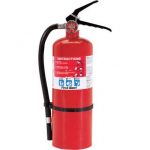 1. Always have a fire extinguisher within reach. Review the instructions on the fire extinguisher to familiarize yourself with proper operation. Hopefully you will never need to use it, but if you do need it, you will not have time to read the instructions. For small wax fires, you may use something such as a pot lid to smother the fire. Never use water to extinguish a wax fire. Liquid wax behaves much the same way as oil, and therefore needs to be treated like an oil fire.
1. Always have a fire extinguisher within reach. Review the instructions on the fire extinguisher to familiarize yourself with proper operation. Hopefully you will never need to use it, but if you do need it, you will not have time to read the instructions. For small wax fires, you may use something such as a pot lid to smother the fire. Never use water to extinguish a wax fire. Liquid wax behaves much the same way as oil, and therefore needs to be treated like an oil fire.
2. NEVER LEAVE MELTING WAX UNATTENDED. It may seem to take a long time to get the wax to go from solid to liquid. But once it has liquefied, the temperature will rise sharply. Make it a habit to constantly monitor the temperature of your wax. If that wax reaches the Flash Point, then the vapors produced are extremely flammable. The flash point of wax is typically above 300° F. Never let your wax exceed 250 degree F.
3. Always use a double boiler (described below). A double boiler helps distribute heat and prevents dangerous temperatures. Never melt wax directly on your stove.
4. Use an electric heat source if possible. If, by accident, your wax reaches the flash point, it is less likely for the vapors to find a flame and become ignited on an electric heat source. Any open flame, such as that found on a gas stove, will ignite wax vapors.
5. Always use a thermometer to monitor your wax temperatures. If you don’t have a thermometer, put it on your list of things to get before you start making candles.
A double-boiler is created by boiling a pot of water on a heat source. The temperature of the water will never exceed 212 deg. F. We then place the pouring pot (containing the wax) within this boiling water. In essence, the pouring pot is never in direct contact with the heat source. The boiling water transmits the heat to the pouring pot quickly and evenly, without scorching the wax and minimizes the chances of a fire. Even with a double boiler, do not leave it unattended.
General Double Boiler Set Up:
- Select an old pot that is large enough to place your pouring pot into.
- Add an inch or two of water to the old pot.
- Bring to a boil.
- Place your pouring pot directly into this boiling water. You may wish to place a metal cookie cutter, or similarly shaped item in the bottom of your old pot to elevate the pouring pot.
- Lower the heat to a simmer. It is not necessary to have a rapid boil. Simmering water and rapidly boiling water are the exact same temperature, 212° F.
- Periodically add water to replace water lost to evaporation. Do not let the double boiler run dry. It can quickly get too hot.
- Allow the wax to melt and monitor the temperature until you reach the temperature needed for the particular type of wax you are working with.
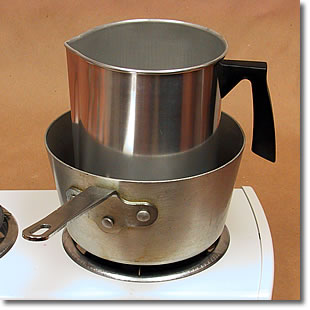

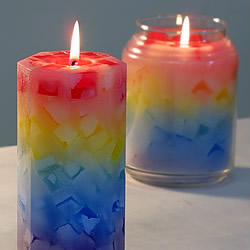
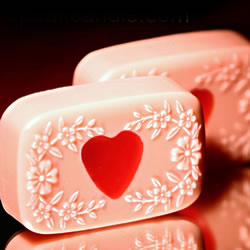
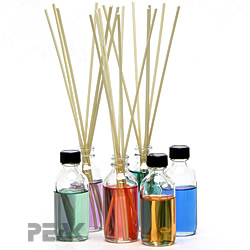
I enjoyed your explanation.
Thanks for the valuable information
Thank you
Thank you, was trying to figure out how to keep “candle” wax pot from touching “water” pot. Cookie mould, how simple. Thank you.
Do you put the thermometer in the wax or in the water to monitor the temperature?
You want to monitor the temperature of the wax. Put the thermometer in the wax.
For fun though, you can put the thermometer in the water to see at what temperature it boils at. The boiling point of water at sea level is 212F, so the water should never get hotter than that. At my elevation, water boils closer to 200F.
Can you put a pouring pot in the oven?
Hi Kate. Are you wanting to put it in the oven for the purpose of cleaning it? If you want details, let me know. I will build another page for that discussion. I am reluctant to answer on this page because I don’t want to encourage anyone to melt quantities of wax in the oven, as it would be extremely dangerous.
Does the curing process change from size of tarts your making?
My wax temperature reaches the required temperature before all the wax has melted. Is this normal?